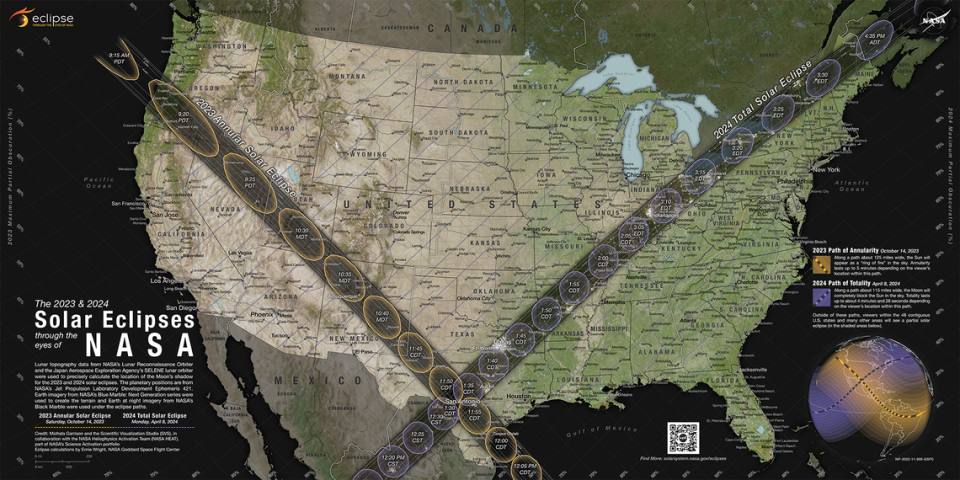Kansas City will see a rare super blue moon this week. Here’s how to catch it
Nighttime skygazers are in for a treat when the moon rises on Wednesday evening over Kansas City.
Not only will it be the second full moon this month, which makes it a blue moon, it will also be a supermoon. Together, that makes it a rare super blue moon.
“This is the third and final supermoon of the year,” said Patrick Hess, manager of the Arvin Gottlieb Planetarium at Union Station in Kansas City. “It will be the brightest.”
While it’s great for people to get excited over rare events like this, Hess also wants to educate them and temper their expectations.
So no, there will not be a giant moon appearing over the metro. And no, the moon won’t actually be blue.
“I want people to be excited not because the moon is going to appear like the Death Star in the sky,” said Hess, referencing the movie Star Wars.
“I want people to be excited because they understand what’s going on in space and they’re understanding the mechanics of the moon’s orbit,” he said. “I want people to be excited because it’s just an excuse to look up into the sky.”
In this case, what people will see is a moon that is about 15% larger and about 30% brighter than usual. So while it should look brighter, you likely won’t really notice it looking that much bigger, Hess said. That’s especially true for people looking at the moon when it’s high in the sky and away from anything to compare to in size.
But that doesn’t mean it won’t be impressive.
“It’ll be a really awesome full moon,” he said.
What is a supermoon, blue moon?
While it can differ from year to year, supermoons typically happen three times a year.
The moon doesn’t orbit the Earth in a perfect circle. Rather, it is more of an oval. That means there are times the moon is closer to Earth than average and sometimes farther away from Earth than average.
As the moon is orbiting, it is also going through its phases. One day on the moon last about 29 1/2 days on Earth, Hess said. When the moon is full and it’s at the closest point to Earth, that is called a supermoon.
To complicate matters, there are different thresholds as to which moons qualify as supermoons, but all agree that in 2023, the two full moons in August qualify, according to NASA Solar System Exploration.
A blue moon, on the other hand, is when there are two full moons in a single month. Blue moons are more rare than supermoons, and only occur every few years. That’s where the term “once in a blue moon” comes from.
To have a blue moon and super moon together is even rarer.
The next one won’t occur again until August 2032, according to the website Time and Date. Meanwhile, others using another threshold to define supermoons has the next one occurring in March 2037.
The next blue moon will occur in August 2024, although it won’t be a supermoon, Time and Date said.
Viewing the super blue moon
On Wednesday, the moon is expected to rise at 8:06 p.m. in the southeast, according to Time and Date. If you have a compass on your phone, look at a bearing of 106 degrees. The moon is expected to set at 7:16 a.m. Thursday in the southwest.
The Gottlieb Planetarium will have a special members-only telescope viewing for Union Station members on Wednesday evening. Tickets can be reserved by going to tickets.unionstation.org/events.
The viewing starts at 9:30 p.m. on the top floor of Union Station’s West Yards parking garage. Although the event is free for members, the standard $6 parking rates apply for those parking in the garage.
The telescope viewing event is subject to weather. People planning to attend should check the planetarium’s Facebook Page on the day of the event for updates.
Telescopes will not be necessary to view the moon, although those who are using them will want to use filters to protect their eyes, Hess said. He added a good pair of binoculars is a great way to get started in stargazing.
Because the sun will be shining directly down on the moon, there will be little to no shawdows on the surface of the moon. He suggested people observing from home view the moon on Tuesday or Thursday night and they’ll see the craters more clearly.
Saturn also it’s brightest, closest
The planet Saturn will also be making a cameo appearance in the night sky near the supermoon.
“Some people are saying that it’s going to be photo-bombing the supermoon,” Hess said, noting the planet will be the brightest and closest it gets to Earth.
For those at the planetarium’s event, they’ll be able to see not only the rings of Saturn through telescopes, but the gaps between the rings and even some of Saturn’s moons.
Hess also encouraged people to mark their calendars for two upcoming solar eclipses. While the experience in Kansas City will not be like the total solar eclipse in 2017, there will be a partial one on Oct. 14. This will be an annular eclipse. Because the moon will be far enough away, it won’t completely cover up the sun. Those in the path of this eclipse will see the “ring of fire” surrounding the moon.
There will be a total solar eclipse on April 8, which can be seen in the Missouri Bootheel. In the Kansas City area, this will also be a partial eclipse.



